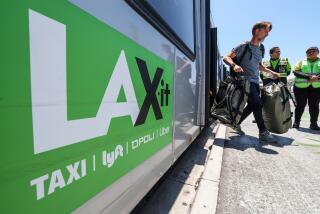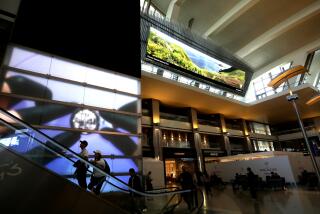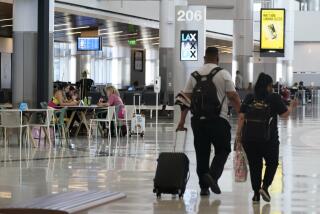New Airport Parking Garage a Maze
- Share via
The man who made the wrong turn in the new John Wayne Airport parking structure said he didn’t have time to talk--only to answer a quick question.
“Yes,” he replied, “it is confusing. This is the first time I’ve been in here. It’ll probably be the last.”
Don’t bet on it.
Beginning today, the new four-level parking structure will be the only unmetered place to park at the terminal. The old parking lot, there since the terminal opened in 1967, has been closed for good as part of the airport expansion project.
(The old metered parking lot remains open, however, and handicapped parking at $5 per day will be switched to the rental-car parking lot.)
Those who use the new parking structure for the first time may find themselves at a loss.
The entrance and exit are placed in a location far from where they were designed to be. Signs are small and often difficult to see. The driving pattern inside the structure is so confusing at one place that two workers have been posted there to direct traffic.
But these are only temporary problems that will disappear with time, according to Alan L. Murphy, project director for the airport expansion. All will be eliminated by the time the new terminal opens April 1, 1990, he said.
The 1,476-space parking structure opened early in March, several months before construction was completed on an elevated airport roadway that runs alongside it. That construction blocks access to the entrance and exit designed in the structure’s east wall.
Until the construction is completed about July 1, cars are entering and exiting through small openings in the south wall.
As before, drivers heading toward the terminal drive under forms for the elevated roadway and follow the road’s swing to the left. But at present, if they want to park, they must turn right where a roadside sign announces “Parking” and into a driveway that seems inappropriately small.
From there, drivers are guided by a maze of yellow boundary tape strung from the entrance to the gate, where tickets are automatically dispensed.
Once through the gate, drivers cruise through the parking lanes, guided by signs that, in order not to reduce overhead clearance, are suspended from the ceiling no lower than the bottoms of the ceiling beams. Being thus located, however, makes the signs impossible to see from a distance, and sometimes they are not visible until cars are almost beneath them.
Curving ramps between parking levels are marked by similarly obscured signs. One sign urging “Caution” cannot be seen until the driver is just about to exit his ramp, and it doesn’t specify what to be cautious about.
The caution is necessary because traffic from three directions merges at the ramp ends--vehicles from the up-ramp, from the down-ramp and from an adjacent parking lane.
What’s more, the driver in the parking lane can easily mistake the ramps for exits and turn onto one of them before seeing the obscured “No Entry” sign.
Once out of the car, you may have difficulty finding a sign directing pedestrians toward the terminal; the signs are tastefully, though inefficiently, small. But airy openings in the structure’s walls allow you to see which way to go.
Once you descend the staircase (the elevators are not yet operating), you walk out the vehicle exit or entrance and turn onto a temporary asphalt sidewalk, which takes you either to one of the shuttles that will drive you the short distance to the terminal or takes you on a short walk to the terminal itself.
“Whenever you have a new structure, there’s always that period of time when people have to adjust,” Murphy said.
He pointed out that the signs now in the structure are temporary because of the structure’s early opening. Two other parking structures are planned for the terminal, and signs for all three have just been designed, he added. The permanent signs will be installed as soon as completed and will be more helpful, he said.
Murphy said the confusion that some drivers experience in the structure will be eliminated once the normal entrance and exit opens in July. He said that any confusion at ramp ends will be eliminated with new signs. “It’s a fairly standard design for ramps, as parking structures go,” he said.
Parking will cost $1 per hour, $12 per day, in the new structure, a decrease in cost over the old lot. The $5-per-day, long-term lot on Main Street remains open.
More to Read
Sign up for The Wild
We’ll help you find the best places to hike, bike and run, as well as the perfect silent spots for meditation and yoga.
You may occasionally receive promotional content from the Los Angeles Times.






